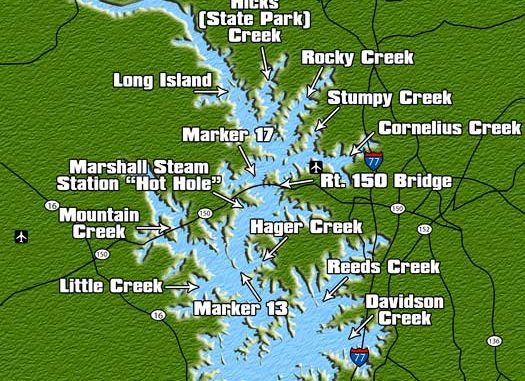
Finding spring striped bass at Lake Norman is about knowing where to start and where to finish.
Spreading across more than 32,000 surface acres, Lake Norman is a pretty big place. But striper anglers trying to figure out where to find fish can eliminate a lot of water just by knowing the habits of their favorite quarry.
Factoring in March opens up a lot of variables because no other month is quite like it — well, maybe just one.
“November and March are the big transition months at Norman,” said Craig Price of Fish On Lake Norman Guide Service. “The first of March, (stripers are) still in a winter (pattern), but by the end of March, you’ve got fish headed to the spawn. And in this neck of the woods, you’ve got a lot of weather fronts coming through.”
But if the average fishermen thinks staying home and saving the cost of $3-per-gallon-gas is a wise move, Price and David Clubb of Clubb’s Guide Service have a few ideas about how to hem in March stripers at the Catawba River reservoir that’s the largest man-made body of water completely within North Carolina’s borders with its 526 miles of shoreline.
First, anglers need to find the right starting point, then they need to discover the right ending point. The rest of the time, they should stay between the two points, keeping in mind stripers are creatures of habit, driven by water temperature, sunlight, food and the urge to reproduce.
The urge to reproduce is preceded directly by the urge to feed, to gain strength for the month of so of prolonged spawning activity.
“March is a good time to fish at Lake Norman; you can catch a lot of 5- and 6-pound fish,” said Clubb (704-202-4608 or 704-663-9441), who hails from Mooresville. “(Stripers) should be gorging, getting ready for the spawn.”
Actually, Norman stripers engage in a “false” spawn because these fish are anadromous species (like salmon) that originally lived most of their lives in the ocean, returning to freshwater streams to lay eggs each spring. However, because Norman’s stripers are land locked, there’s not enough free-flowing water to bring off an actual spawn. But the instinct to swim upstream when the water warms to the right temperature is hard-wired into them, so each spring they start moving against the current, heading for spawning grounds that can’t be accessed because of the dams on the Catawba River.
Price (704-996-0946), who lives in Denver, agrees March is a big feeding month for stripers, even though they may change locations drastically during those 31 days.
“They’re as plump in March as they’re gonna get,” he said.
So where is the starting point? Price and Clubb generally agreed it’s near the mouths of a handful of major creeks near the mid-lake area.
Clubb said Davidson, Mountain, Rocky, McCrary and Hager creeks will hold major populations of stripers during the late winter and early spring. He likes to target them early in the month from the creeks’ mouths to about halfway back, looking for places where fish can pull up in shallow water to feed without having to move far from deep water.
Price keeps tabs on wind direction and fishes areas early that are affected by the warm-water discharge from the Marshall Steam Station. The station’s “Hot Hole” dumps into the lake at the western shoreline between the Rt. 150 bridge and the mouth of Mountain Creek.
“McCrary and Hager Creek are probably the two main creeks that get the most effects from the Hot Hole,” he said. “The warm water can be up to the mouth of Stumpy Creek above the bridge or down south to the mouth of Mountain Creek. And a degree’s difference in temperature is a big deal to the fish when the (surface) temperature is 45. And the Hot Hole effects extend two miles in either direction.”
Clubb said he’s seen a temperature difference of as much as five degrees between “Hot Hole” water and water that’s not affected.
“You fish the side of the lake the wind is blowing on,” he said. “On a southwest wind, you might fish the red-clay flats up at (marker) 17B, and McCrary Creek is awesome in March on that wind. On a northeast wind, you fish Mountain or Hager.”
Clubb said the continuing expansion of blueback herring in Lake Norman is changing the way stripers act. Instead of feeding on threadfin and gizzard shad, open-water forage fish that orient more to shallow water, stripers are able to live and feed in deep water on herring, locally known as alewives, that are even more of an open-water fish than shad.
“The first of March, (stripers) should be in the creeks, pushing bait to the banks,” he said. “But this year may be totally different from the past.
“I think all of the records I’ve kept may be out the window. I don’t know, but they were so easy to pattern in 2007. I don’t know if it was the lack of rain or the lack of (current). And why should they have to move up to feed? There’s plenty of food out there in deep water.”
Price agreed with Clubb’s analysis.
“I’m fishing deeper than I used to,” he said. “I can’t say (the 2007 drought) was a factor, but it seems like even before the water level came down, I was fishing deep. It may have to do with the introduction of bluebacks. The (stripers) don’t move up shallow as much as they used to.”
The one exception, he said, is if extremely cold weather occurs and causes a die-off of temperature-sensitive threadfin shad. That usually occurs at the backs of creeks where shad have migrated to try and avoid the chilling water that gives them such problems. But often their best efforts aren’t enough, leaving the surface littered with dying or dead shad and providing a great buffet for gamefish.
“The main body of stripers will be out on the main channel, but they’ll go back, and you’ll catch a lot of fish there when the shad die off at about 45 degrees,” Price said. “Those small threadfin go back in Rocky, Stumpy or Cornelius creeks and get caught back there and die off.”
Shad die-offs aside, the guides are looking for fish in deeper water early in the month. They search for concentrations of bait near “humps” (underwater mounds), points and creek-channel bends. It’s not unusual for fish to feed in 25 feet of water, suspended above 35- to 40-foot deep bottoms in a channel.
“I like to fish long, sloping points with deep water nearby — 30 to 40 feet in the creek channel,” Clubb said. “They’ll be up early, shallower, on flats and points, but as the sun comes up, around 10 (a.m.), you drop back off and fish about 30-feet deep.”
“Everything is always relating to some kind of bottom topography — banks, points, humps and what I like to call ‘pinch points’ — places where you’ve got the deepest water in the channel going back into a creek,” Park said. “It can be two steep banks or two points pushed up against the channel. It’s just something that pinches the deep water.
“The fish are always going to go through a pinch point to get in and out. These are places where you can find large bunches of fish because they can push the bait up against some kind of structure. It sort of narrows the playing field.”
That situation causes the guides to reach for “down rods,” outfits in the medium to medium-heavy class, either spinning or baitcasting with the key a fairly soft rod tip.
Clubb likes to use 20-pound-test monofilament with his Shimano Stradic spinning reels and a 2 1/2-foot leader of 15-pound fluorocarbon that’s attached to a barrel swivel. Above the swivel, he threads an egg sinker anywhere from 2 to 4 ounces. These heavy sinkers keep the baits, which are pinned to a No. 6 treble hook, vertically below the boat at a specified depth.
Price likes to fish bait-casting outfits — Shakespeare rods and Penn 6500/7500 or Abu-Garcia 5600C4 reels — with 12-pound green Trilene Big Game line and 2 to 3 feet of 15-pound-test fluorocarbon leader. He uses egg sinkers from 1/2 to 2 ounces and hooks his baits on 2/0 or 3/0 circle hooks — depending upon the bait’s size.
“The first of the month, you’re using smaller baits — a lot of people use (rainbow) trout,” Price said. “As the water warms up, you can start to use bigger baits.
“In April, I’m pulling as big a bait as I want to pull. But I really like to use an assortment of sizes. Any fish will eat a smaller bait, and you should never be surprised by how small a fish will eat a big bait.”
“Once I’m where I want to fish, say, a point that’s 25-feet deep, I’m going to put my heaviest one or two rods close to the bottom because sometimes there’ll be some inactive fish down there you don’t ever really mark (on your depth-finder). But if you put a bait in front of them, they’re going to eat it.
“I’ll stagger my rods (and bait depths) all the way up to 15 feet, and maybe even fish a free line or planer board. I want the deeper rods closer to the bow, and I step them up all the way back to the transom.”
As the month progresses, fishermen need to keep a close eye on the weather. Cold snaps will lower the water temperature and either push stripers toward the main river channel or cause the “hot-hole effect” to increase. But a gradual warming trend, with the surface temperature staying above the 50-degree mark and approaching 55, will get stripers to start thinking about their spawning run.
The hard spawn doesn’t take place until later, normally in April, but lasts as late as Memorial Day. It typically takes place in the upper reaches of the Catawba River, close to the Lookout Dam tailrace, or in the extreme backs of creeks at rocky shoals or eddies.
Lake Norman stripers will spawn during a period of about six weeks in a variety of locations, often dictated by the presence or lack of current.
“They’ll start migrating to the backs of creeks at the end of March. Stripers will pick up current and move upstream to spawn,” Clubb said. “I don’t think as many fish go up the river to spawn as they used to, but the river can substitute for a creek with current.”
Price said that he generally considers Marker 13 near the mouth of Hager Creek as an invisible dividing line. Below that area, stripers rarely make a move up the river to spawn, and are more likely to move into the bigger creeks at the lower end of the lake. Above that area, stripers will go up the river past Long Island toward Lookout Dam or move into the main creeks such as Rocky, Stumpy, Cornelius or State Park (Hicks).
“I live at the south end of the lake, and as you get toward the end of the month and into April when the spawn starts, what you see at Norman is that there isn’t enough detectable flow, so the fish on the south end don’t know where upriver is,” Clubb said. “They scatter into Davidson, Mountain or Hager creeks, and they spawn at shallow flats and shoals.
“I really like to fish the flats in the back of Davidson and Reeds (creeks). If there was flow coming out of the river all the time, more fish would go up there, but because the flow is intermittent — no rhyme or reason — once they commit to go back in a creek, why would they move out and try to go up the river?
“The fish above the Rt. 150 bridge, they’re they ones that look to head up the river to spawn.”
When stripers move back into the creeks to stay, Clubb starts to look for places where the fish easily can move to the shallows to feed. He likes red-clay flats because the bottom warms up and holds heat, attracting baitfish. And he likes big pockets off the main creek channels.
“Early in the day, stripers will move up into pockets or on flats to feed,” Clubb said. “I’ll fish free lines or planer boards, and you can even just pitch a live bait up there with a spinning rod. McCrary Creek is the best to do that early in the morning.
“As the sun gets brighter, you back off and fish deeper water. I won’t be surprised to catch a ‘teenager’ (a fish between 13 and 19 pounds) then on a down rod.
“If you fish up in the river, you’re looking to pitch live baits around tree tops, rocky shoals, eddies. There are plenty of places like that.”
Price said bluebird days have produced a lot of his biggest stripers, “contrary to common knowledge about stripers,” he said. “And shallow flats can be dynamite for fish that are cruising along, looking for crappie and bream that have moved up. They don’t have to chase those little shad all the time.”
Smaller male stripers will be the first ones to show up at the extreme backs of creeks, with bigger females a few days to a week behind.
“When you get that 55-degree water, they’ll be getting ready, but they don’t all go at the same time,” Price said.


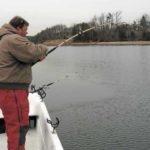
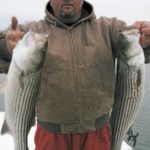
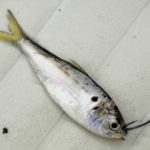
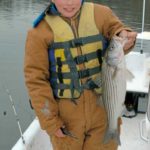
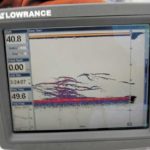
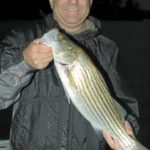



Be the first to comment